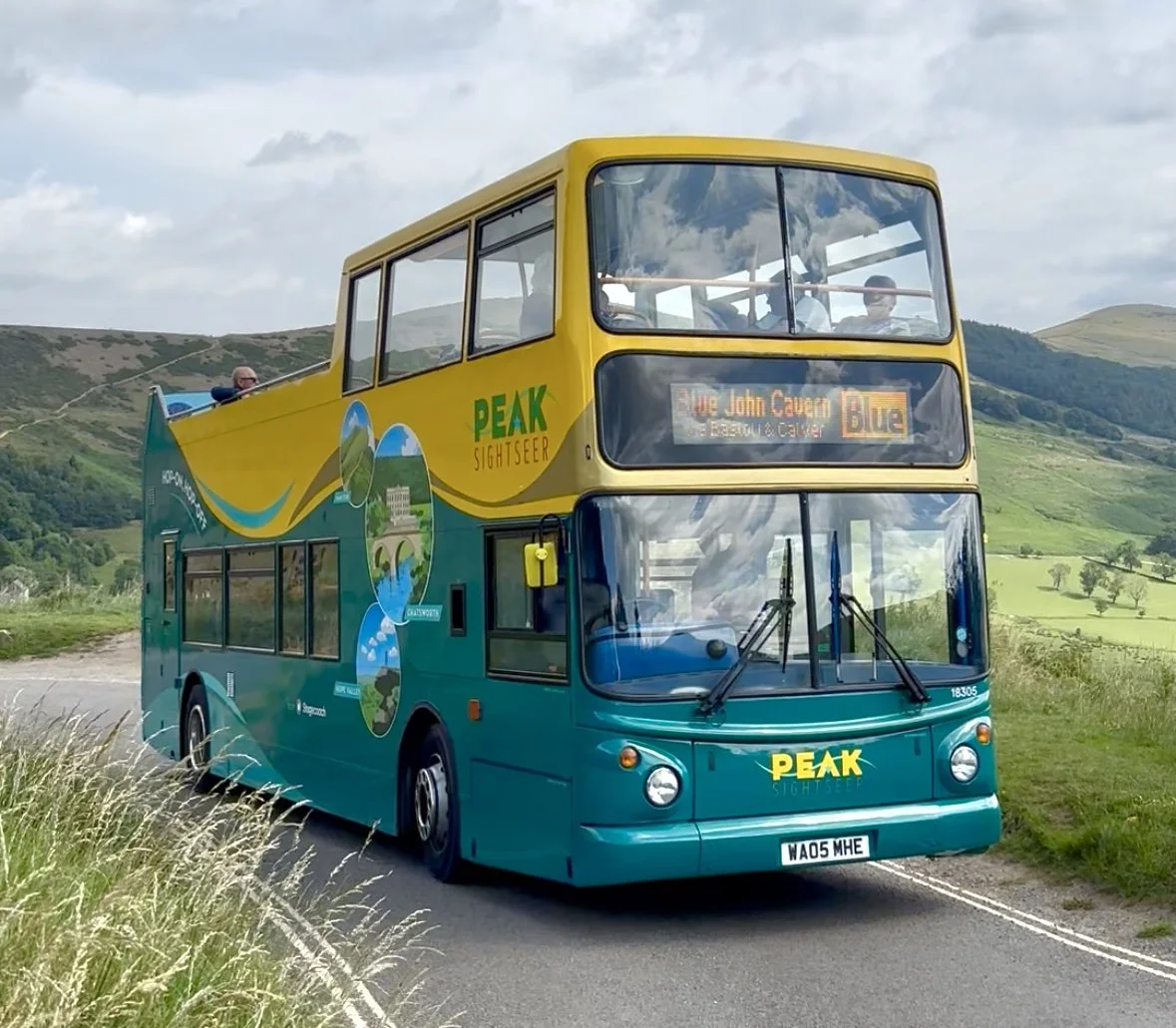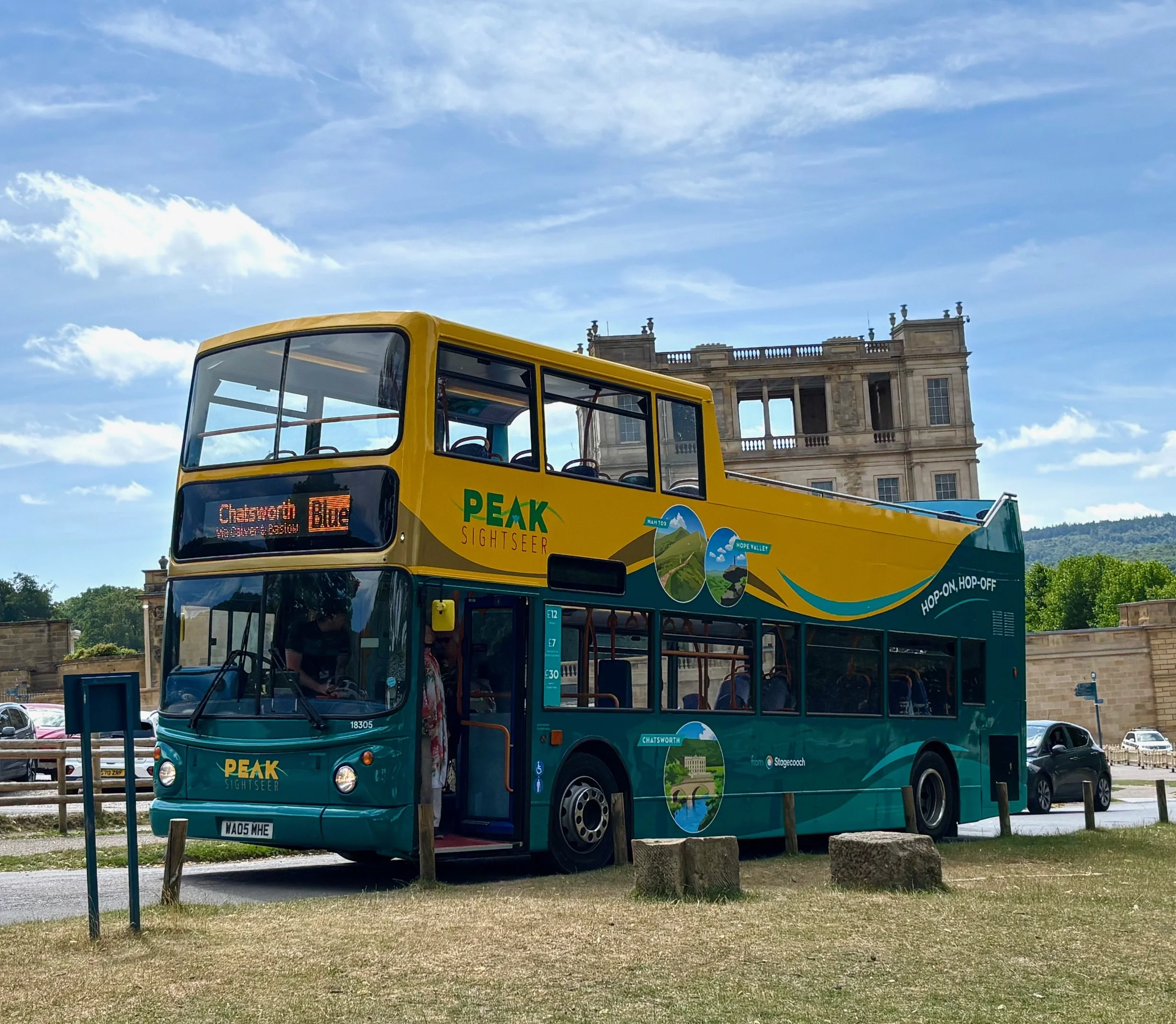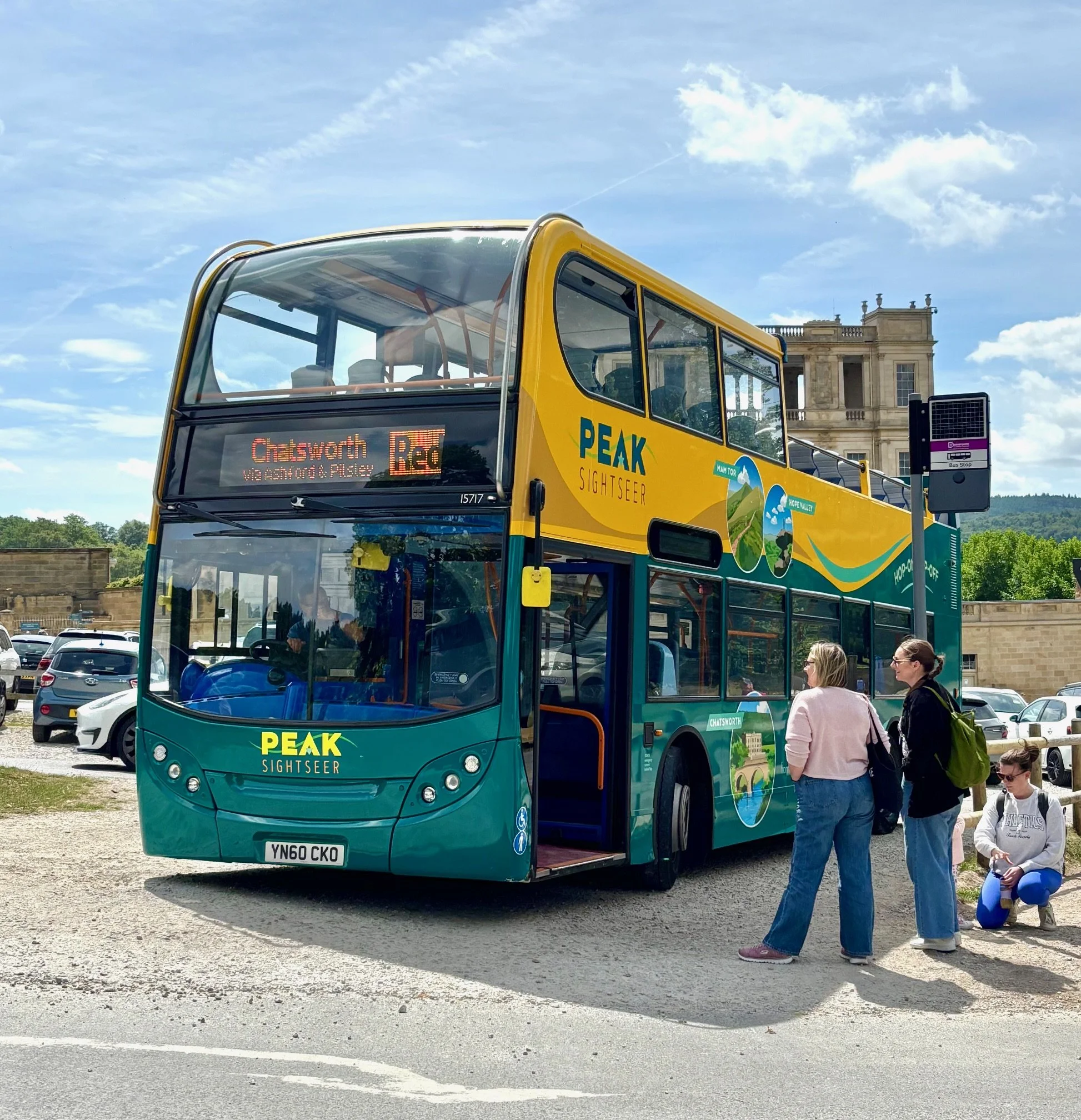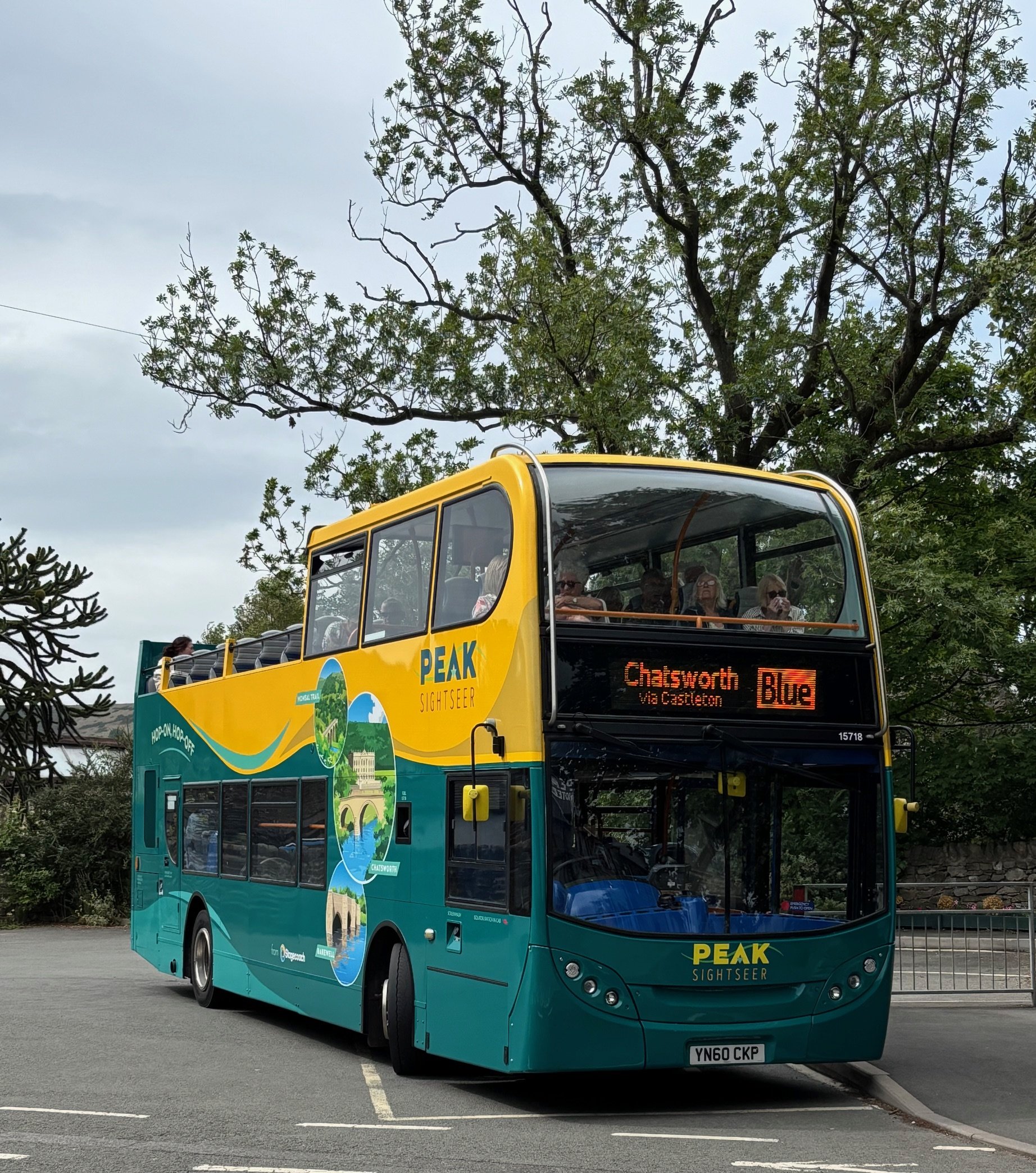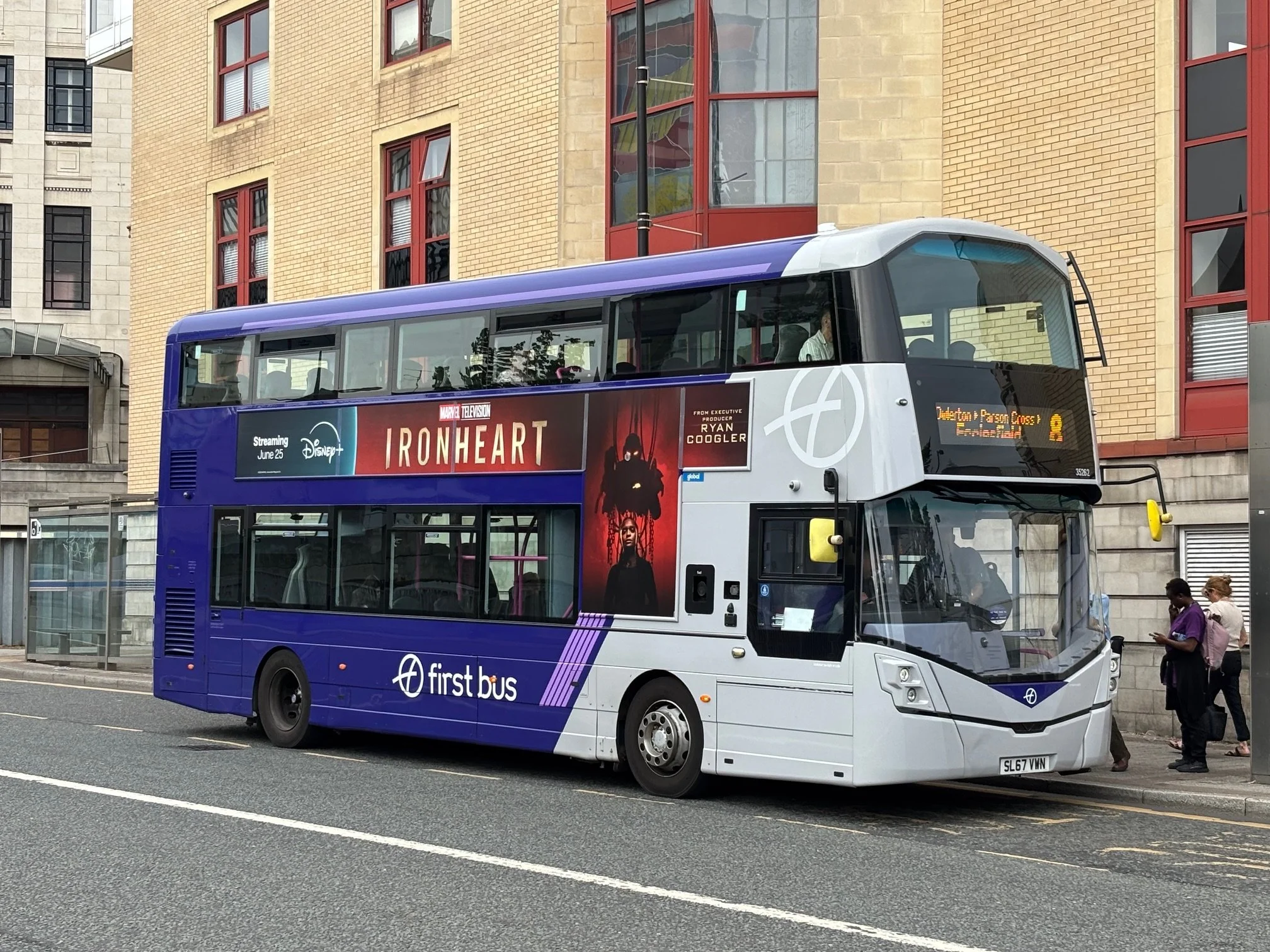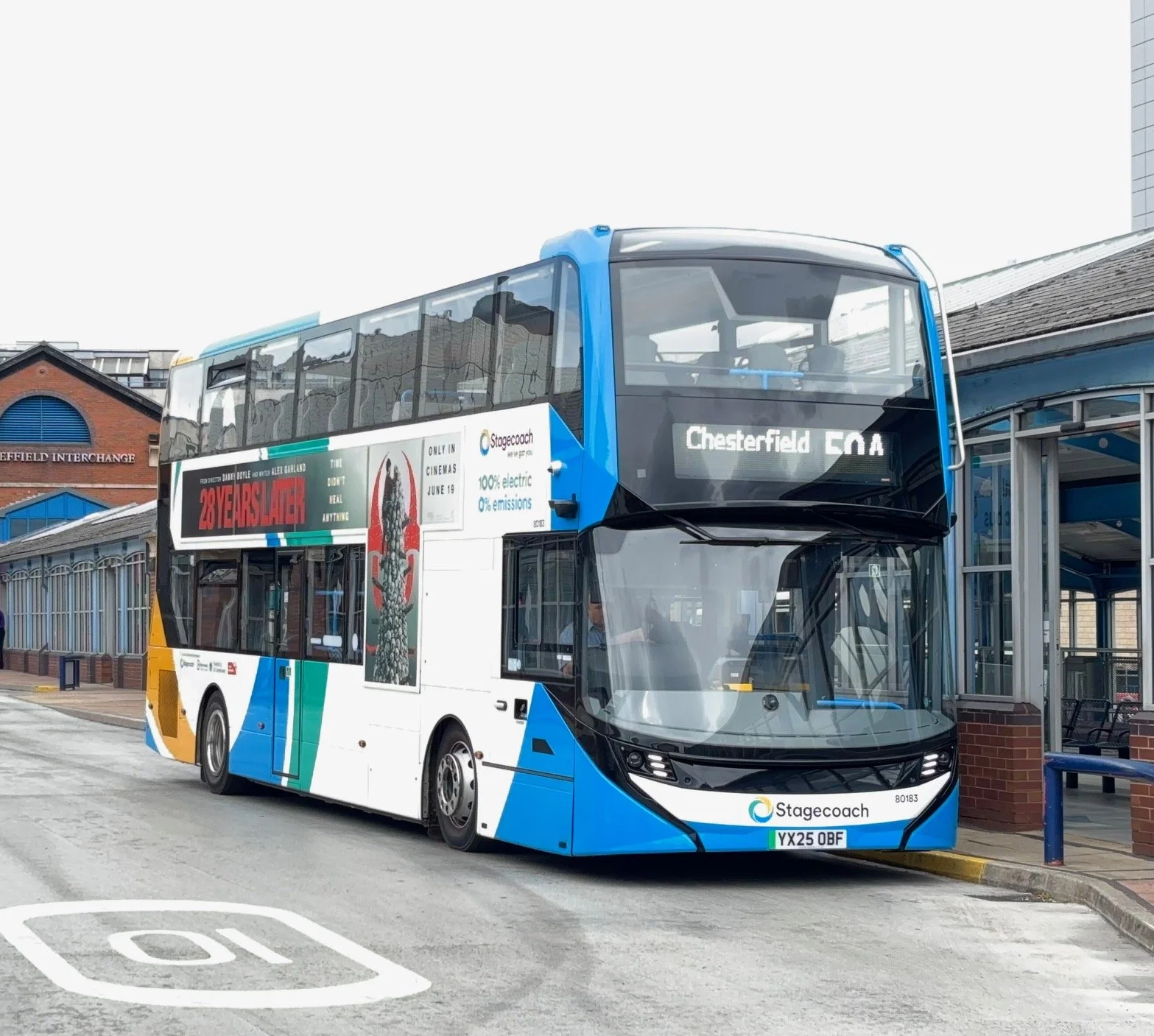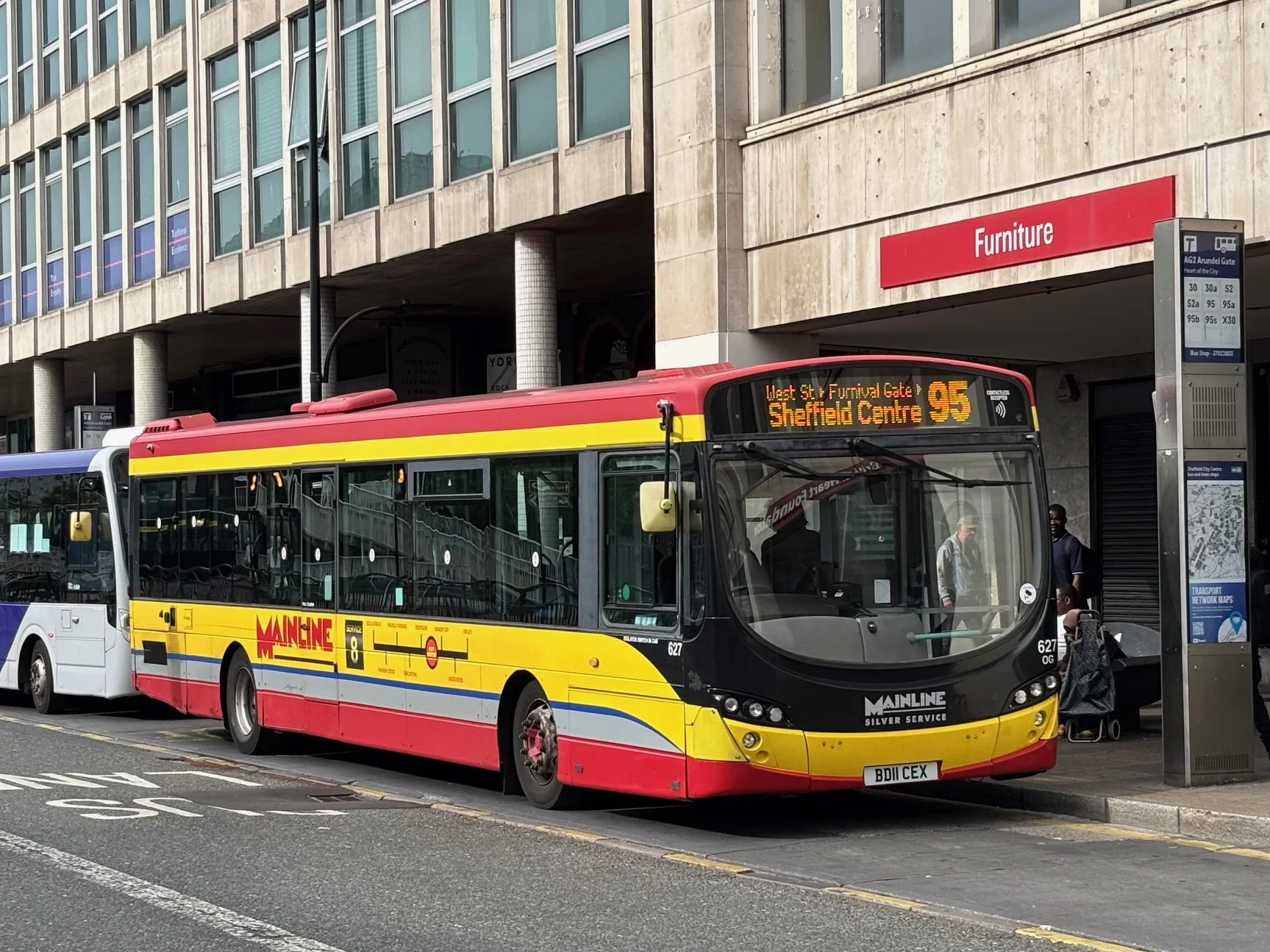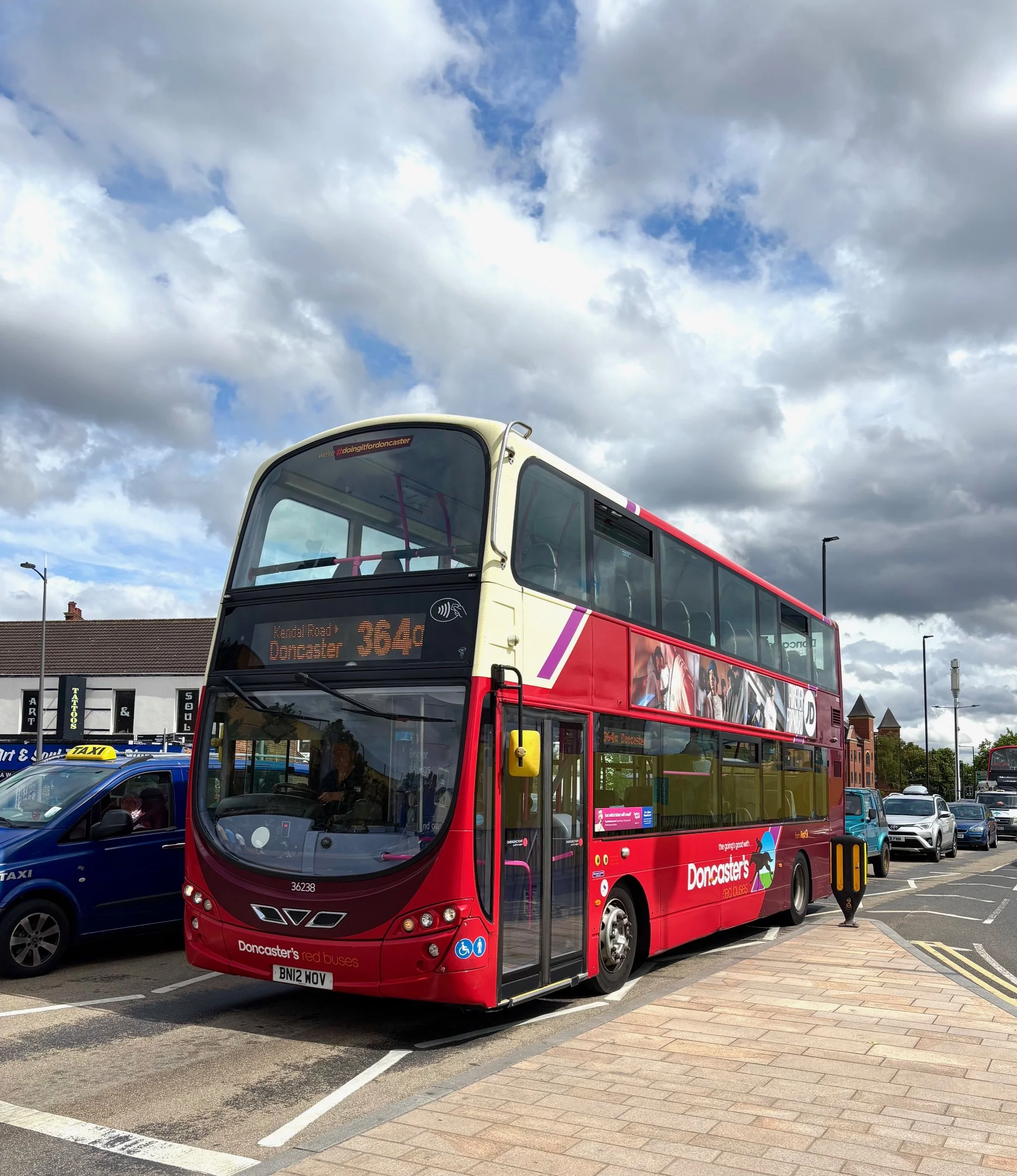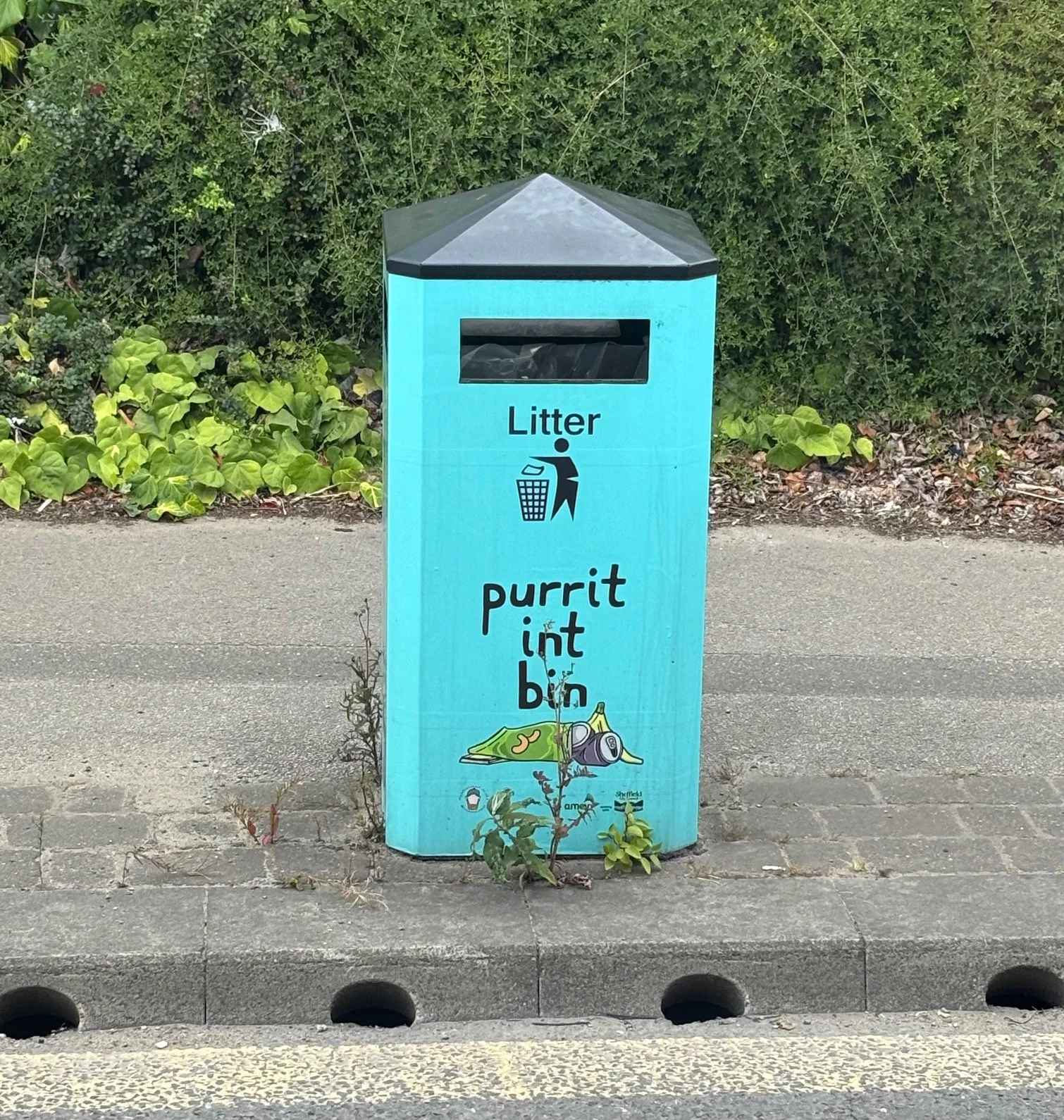Open Tops in the Peaks & Electrics in Chesterfield
In the final part of my South Yorkshire adventure, I cross the border into Derbyshire and ride Open Toppers in the Peak District plus new electric double deckers to and from Chesterfield, before returning to my start point at Doncaster.
Highlight of the trip had to be a ride on an Open Top Trident ALX400! Stagecoach 18305 of Chesterfield Depot is seen on the Peak Sightseer “BLUE” route at Blue John Cavern amidst glorious scenery.
This bus is one of three Tridents in this special livery and was formerly with Stagecoach Devon on “Bayline” routes in Torquay.
First Yorkshire 272: Sheffield to Castleton
Day 3 of my South Yorkshire adventure and I made my way to Sheffield Interchange for a trip over the border into Derbyshire and the Peak District using Route 272 to Castleton. Unusually, this is a joint service between two operators - First Yorkshire and High Peak - which together provide an approximately hourly service Daily during daytimes with a limited evening service of a couple of journeys.
Whilst High Peak tend to use single deckers, First Yorkshire provide double deckers on most of their journeys and I had Wright StreetDeck Ultroliner 35935 on the 0946 departure. This was a low height example transferred in from First York and in a red and dark blue livery. A low bridge in the Hope area has necessitated the use of such vehicles.
A reasonable number of visitors boarded with me and we left a few minutes down on schedule. A swift departure through the city with very few others joining us as we progressed through the suburbs along Ecclesall Road. After passing through Whirlow, we left the built-up area behind and sped up as we entered the open country that characterises the Peak District. At Fox House, basically a pub in the middle of nowhere, we picked up a couple of takers before entering the scenic section of route downhill into the Hope Valley. There is a stop called “Surprise View”, where one can alight for a magnificent vista of the valley far below together with the surrounding peaks and moorland. Plenty of hikers and sightseers in evidence in the area.
At the bottom of the hill, we called at the picturesque village of Hathersage, where Little John of Robin Hood fame is buried in the churchyard. The route then continues along the Hope Valley following the River Derwent, with a brief double run to serve the stop at Bamford Station, close to the small village of the same name. Back on the main road for a short distance, before diving off once again down a narrow lane to serve the pretty village of Bradwell. The terminal loop here involves some extremely narrow roads with our decker having to squeeze between two high sided stone buildings followed by a sharp 90 degree left turn - requiring a skillful manoeuvre by the driver!
After the double run back up the lane, we resumed progress westwards on the main road, serving the village of Hope with picturesque little church before the final stretch into Castleton, terminating at the Bus Station after a 65 min run from Sheffield.
Rear view of Trident 18305 showing the special signwriting for the Peak Sightseer Routes with pictures of some of the attractions served.
There are two routes based on Chatsworth House, operating Daily from late May to mid September and then weekends only until end of October.
Stagecoach BLUE: Castleton to Blue John Cavern
A short walk from the Bus Station at Castleton is the Visitor Centre where information can be obtained on the various attractions in the area. Apart from cafes, pubs and souvenir shops, the village is overlooked by Peveril Castle, which dates from Norman times and can be reached by a short uphill walk.
However, one of the best ways of seeing the area is by Peak Sightseer Open Top Bus, operated by Stagecoach out of their Chesterfield Depot. A fleet of 6 buses run on two routes - 3 Trident ALX400s and 3 Enviro 400s providing the service, all in a special turquoise and yellow livery with signwriting and pictures of points of interest served.
I was in time to catch the 1100 departure on the “BLUE” route, which operates between Chatsworth House and the Blue John Cavern, picking up opposite Castleton Visitor Centre, where buses depart hourly between 1000 and 1700 during the operating season. In 2025, this is daily from 24 May to 21 Sept and weekends only from 27 Sept to 25 Oct. My bus was one of the Tridents - 18305 - a former Stagecoach Devon vehicle which previously operated on “Bayline” Open Top routes in Torbay.
Most passengers alighted in Castleton and just a few continued with me on the 10 min run beyond the village, where the main road ends and we continued on a winding lane up through the barren moorland to the terminus at Blue John Cavern. This must rate as one of the most scenic terminals in England, with amazing views of the surrounding peaks and the Hope Valley, Castleton being far below. The nearby caves can be explored, this being the place where Britain’s rarest mineral, the Blue John stone, has been mined since Roman times and turned into jewellery which can be purchased at shops in the area.
Alternatively, one can hike the steep climb up Mam Tor (517m) for even better views of the surrounding landscape and from where various walks are possible taking in adjacent peaks along the Great Ridge.
Trident 18305 at the other end of the BLUE route, Chatsworth House, after my trip on it from Blue John Cavern.
An Hourly service operates on this route between approx 0900 and 1800 requiring 3 buses.
Stagecoach BLUE: Blue John Cavern to Chatsworth House
After the layover, I rejoined 18305 for the full run along the route. A small number with us as we departed along the winding and windswept road back down into Castleton, although we picked up a few more at the Bus Station. Then it was back through the Hope Valley, calling at Hope, Bamford and Hathersage following the River Derwent. Then uphill to Surprise View which I had passed earlier in the opposite direction on the 272, before turning off through the ancient woodlands of the Longshaw Estate and Padley Gorge, where there are a series of waterfalls.
A brief pause to await time in the next village of Grindleford, before continuing along the road to Calver, with views of Frogatt Edge, Curbar Edge and Baslow Edge to the left, where walks are possible along the high escarpment. At Baslow, another short wait in the attractive village, before the final section through the rolling countryside to the terminus at Chatsworth House, approaching through the large grounds with grazing animals in evidence. A very pleasant 1h15m ride end to end.
Chatsworth House itself has been home to the Devonshire family for 16 generations and is worth a visit. 25 rooms in the house can be viewed to discover its art and history, whilst the 105 acre garden features an arboretum, rock gardens, fountains and sculptures.
Stagecoach Enviro400 15717 on the “RED” route of the Peak Sightseer at Chatsworth House, before my circular ride on it via Bakewell. Buses run hourly on the service between about 1000 & 1700 with extra trips in School Summer Holidays.
This is one of three Open Toppers of this type on the Peak Sightseer, which share operations with the three Tridents.
Stagecoach RED: Chatsworth House & Bakewell (Circular)
After a brief stretch of the legs, I switched to the second of the two Peak Sightseer services, the RED route. This operates as a circular from Chatsworth House via Bakewell, with departures every hour from 0955 to 1655 during the season mentioned earlier. Additional departures during the School Summer Holidays provide a 30 min service for much of the day.
I boarded 15717, this time one of the Enviro400s which share the services with the Tridents. Initially, I had the bus to myself, but unlike the previous one, this vehicle featured a pre-recorded commentary on points of interest as we progressed along the route. After making our way back through the grounds, we reached the nearby village of Pilsley, where the Chatsworth Estate Farm Shop selling fresh produce is located. Continuing along the lane, we soon came to Hassop Station, on the disused railway line between Matlock and Buxton, much of which now forms the Monsal Trail for hiking and cycling.
We then entered the circular section of route, which describes a long one-way loop. A short distance along Hassop Road, we came into the town of Bakewell, with a few minutes hesitation in the centre. The town offers the chance to stroll through cobbled alleyways and courtyards between stone buildings. There is an ancient bridge and some riverside walks, together with the opportunity to sample some original Bakewell Tart for which the town is famed, available in local shops and cafes.
After gaining several more passengers in Bakewell Town Centre, our bus continued along Buxton Road to the next scenic village of Ashford in the Water, with medieval bridge, limestone cottages, gardens, church and pubs. From here, we made our way along Baslow Road to complete the loop back to Hassop Station and the reverse of our outward route to Chatsworth House. 50 mins for the whole round trip.
Back on the BLUE route, my third Open Top Bus of the day was Enviro400 15718, seen at Castleton Bus Station at the conclusion of my rides on the Peak Sightseer.
Day Tickets on the two routes cost £12 for Adults and £7 for Under 19 & Concessions.
Stagecoach BLUE: Chatsworth House to Castleton
Back at Chatsworth, it was time to complete the circuit on the Open Toppers, by taking the BLUE route back to my start point at Castleton. On this occasion, the vehicle was another of the Enviro400s, 15718. A few takers but quieter than the morning trip had been, for the 55min ride. Alighting at the visitor centre, I had time for refreshments in the adjacent tea rooms before catching the bus home.
Before leaving the Open Top routes, although I didn’t travel on them, there are a few “hairy” journeys at start and end of service. A few trips operate from Chesterfield Railway Station to Chatsworth in the morning and back in the late afternoon, with a couple of others operating to and from South Sheffield (Lowedges) in the same way. Presumably this is a way of “livening up” the garage journeys from and to the depot.
An attractive leaflet is produced with timetables and maps of the Peak Sightseer routes, available at local information offices and in racks on the Open Top buses.
First Yorkshire 272: Castleton to Sheffield
After my tea break, I proceeded to Castleton Bus Station for the 1601 departure back to Sheffield on the 272. Another Wright StreetDeck Ultroliner, 35936, on this trip. Plenty on and off throughout in ones and twos, although we saved some time by not doing the Bradwell double run on this journey. Once onto the country section beyond Hathersage, a fast run ensued until we reached the surburban part of the route into the city. Nevertheless, at 50 mins for the trip, we were 15 mins quicker than the outbound run, a good end to the day.
My trip to and from Castleton was on First Yorkshire Route 272 from Sheffield. Wright StreetDeck Ultroliner 35936 is typical of the type used and is seen after arrival back at Sheffield Interchange at the end of the day.
This vehicle is one of a small number transferred from First York with reduced height for passing under a low bridge on the route.
The driver has already changed the destination for the vehicle’s next trip on Route 207 to Whiston, as interworking is common in Sheffield.
Another First Yorkshire Wright StreetDeck Ultroliner at Arundel Gate in Sheffield City Centre on Route 8 (Birley - Ecclesfield) illustrates the new “first bus” livery.
This adds yet more variety to the many different liveries seen in the city and provides a comparison with the lowbridge version seen above.
Stagecoach 44: Sheffield to Chesterfield
Day 4 and there was time to fit in a return run to Chesterfield before leaving Sheffield. This provided an opportunity to ride the new electrics which Stagecoach have introduced in recent times and to complete my personal jigsaw of bus rides by linking up with the destination I reached from the opposite direction earlier in the year, when I visited Chesterfield from Mansfield by bus.
There are two sets of routes between Sheffield & Chesterfield, the most direct being the 43/44 via slightly different intermediate routeings. The former runs hourly M-S daytimes and the latter every 30 mins during this period with an hourly evening frequency. There is a 42 route which short works between Sheffield & Lowedges, providing a joint 15 min headway over the common section M-S daytimes. On Suns, the 43 & 44 provide a joint 30 min daytime service, reducing to hourly in the evening.
I joined Enviro400EV 80169 from its start point outside Sheffield Interchange, which is odd given that there is plenty of space in the Bus Station itself. All expected modern features provided, including high backed seating, USB ports and next stop screens / announcements.
The expected smooth ride as we departed the city, along London Road and Chesterfield Road, although on the city outskirts we turned off to serve various housing areas on approach to the main intermediate town of Dronfield, calling at the station and other stops in the centre.
After this, a few bits of intermediate countryside, before arriving into the Chesterfield suburbs. Passing the Stagecoach Depot at Stonegravels, we made slower progress into the town centre, terminating opposite the Coach Station. A 65 min journey, well used throughout.
Stagecoach Enviro400EV 80169 at Chesterfield Coach Station after my ride on Route 44 from Sheffield via Dronfield.
Stagecoach have introduced a fleet of electric double and single deckers at Chesterfield Stonegravels Depot recently, with sponsorship from Derbyshire County Council and the Government.
Stagecoach 50: Chesterfield to Sheffield
For the return run, I had intended to ride the companion route to the 44, the 43. However, the 1104 departure from Chesterfield was cancelled - the only service during my trip that didn’t show up! A check on bustimes.org revealed that the inbound bus was running some 15 mins late and was terminated short at Stonegravels Bus Garage, hence its non-appearance in the town centre.
However, there was a 50 due 10 mins later and this turned up on time, formed of another Enviro400EV, 80183. The 50/A routes run between Chesterfield and Sheffield via a more easterly route than the 43/44, the main intermediate town being Eckington, within which slightly different intermediate routes are followed by the plain 50 and the 50A. Buses run alternately on a joint 30 min frequency M-S daytimes, Hourly eves and Suns on the 50 only.
Leaving Chesterfield, we followed the same route as the 43/44 at first, past the Stagecoach Depot to Whittington Moor, before parting company and serving the large settlements of Old Whittington and New Whittington. We then made our way via various estate roads into Eckington, calling at the small Bus Station in the centre of this former iron forging and coal mining town. After this, due to the direct route being closed for roadworks, we made a lengthy diversion via various narrow back streets, before coming back onto the main road and slow-moving traffic, almost back to the point we had departed from 10 mins before!
After this though, we sped up through more open country, before crossing back from Derbyshire to South Yorkshire at Mosborough. All too soon we entered the Sheffield suburbs and made a gradual downhill run via Manor Top, picking up and setting down at various stops, all the way back to Sheffield City Centre. A longer run than the outward one at 1h15m.
Another Stagecoach Enviro400EV, 80183, back at Sheffield Interchange after riding it on Route 50 from Chesterfield via Eckington.
The bus is returning to Chesterfield on the 50A variant. There is much interworking between the Sheffield - Chesterfield routes 43/44/50/50A.
Before leaving Sheffield, I came across this First Yorkshire Volvo B7RLE 69527 of Olive Grove Depot in this pleasing retro livery for Mainline. Seen at Arundel Gate on a short working of Route 95 from Walkley to the City Centre.
Retro liveries seem to be popular with First Yorkshire, various examples seen in both Sheffield and Doncaster.
First Yorkshire X2: Sheffield to Doncaster
It was now time to leave Sheffield for the last time and return to my start point at Doncaster. Having taken the more direct and more frequent X3 on the outward run at the start of my trip, I opted for sister route X2 for the inbound journey, which operates a lengthier route via Maltby. The X2 runs Hourly M-S, with additional shorts Sheffield - Maltby providing a 30 min service over this section. Sunday sees a 2 hourly through service, with shorts Sheffield - Rotherham providing a joint hourly frequency.
The X2 is a double deck / single deck mix, but I had Volvo B9TL 37556 in old First livery. A reasonable number on board as we left Sheffield, proceeding north to Meadowhall, but via Brightside Lane rather than Attercliffe Road served by the X3. An exchange of passengers at Meadowhall Interchange, where a large number of home-going shoppers joined us. From here to Rotherham, the routes again part company, the X2 serving Meadow Bank Road and more housing than the industrial route favoured by the X3. Into Rotherham Interchange, where there was again a few minutes hesitation built in to the schedule.
Out of Rotherham, a longer route back to Doncaster than the X3, serving the main Bawtry Road with some fast dual carriageway sections, although largely urban. Through Bramley to Maltby, another former mining town, which forms part of the Metropolitan Borough of Rotherham and where half the M-S daytime service terminates. Almost all alighted here and it was only three of us that continued over the countrified section beyond, calling at the villages of Braithwell and Edlington. By now, we were back into the suburbs of Doncaster, where we picked up a few more passengers, rejoining the X3 at Balby for the final section into town. A lengthy 1h45m trip but an interesting one, with a variety of urban and country scenery.
Back in Doncaster at the end of my adventure, although I didn’t travel on it, an excuse to illustrate the red/maroon/cream livery used by First Yorkshire on local routes.
This is Volvo B9TL 36238 on the 364A passing Doncaster Railway Station on a circular service via Bentley and Arksey. I had travelled various local routes on a previous trip to the town.
Journey’s End
I finished where I began, back at Doncaster Interchange, adjoining the Railway Station. There was about 20 minutes before my train home to observe a few bus comings and goings, but no more rides, although I had visited the town once before, some years ago, to do some of the local routes. At that time, I recall that Volvo Alexander ALX400s were the principal type, since supplanted by Volvo B9TLs, themselves now getting somewhat long in the tooth!
I then repaired to the station to catch my LNER Azuma back down south.
Watton
And finally…
These litter bins are a common sight at Bus Stops in Sheffield and rely on the local vernacular to get the message across!

